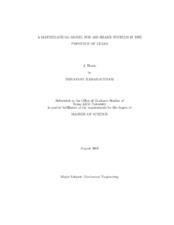| dc.description.abstract | This thesis deals with the development of a mathematical model for an air brake
system in the presence of leaks. Brake systems in trucks are crucial for ensuring
the safety of vehicles and passengers on the roadways. Most trucks in the US are
equipped with S-cam drum brake systems and they are sensitive to maintenance.
Brake defects such as leaks are a major cause of accidents involving trucks. Leaks in
the air brake systems affect braking performance drastically by decreasing the peak
braking pressures attained and also increasing the time required to attain the same,
thereby resulting in longer stopping distances. Hence there is a need for detecting
leaks in an air brake system.
In this thesis, a mathematical model for an air brake system in the presence of
leaks is developed with a view towards developing an automatic leak detection system
in the near future. The model developed here builds on an earlier research at Texas
A&M University in which a "fault free" model of an air brake system is developed,
i.e., a mathematical model of an air brake system that predicts how the pressure in
the brake chamber evolves as a function of the brake pedal input when there are no
leaks in the air brake system.In order to develop a model for an air brake system in
the presence of leaks, one must characterize a "leak". A leak may be characterized by
the location and its size. Since the pipes are short, the location of the leak does not significantly affect the evolution in the brake pressure as much as its size. For this
reason, "effective area" of the leak was chosen as a characteristic of the leak. It was
estimated by fitting an empirical relation for leak with leak flow measurement data.
The supply pressure and effective area of leak comprised the inputs to the model
along with the displacement of the foot pedal (treadle valve plunger). The model was
corroborated with the experimental data collected using the setup at Texas A&M
University. | en |


